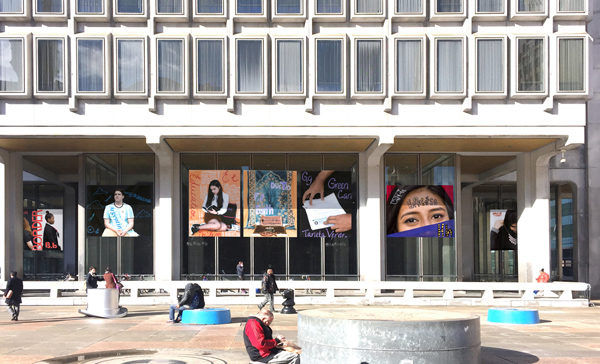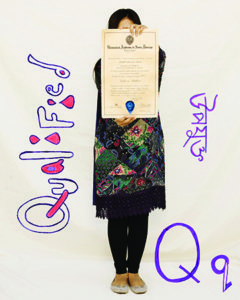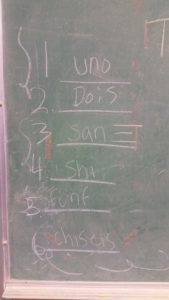
Reflections from the Other End of the Alphabet
Written by Yannick Trapman-O’Brien; Project Assistant
No person is 100% from anywhere. I’m Irish! But you’d never see it, except in my nose! Does that make me less African? No! My grandmother is Native American – on both sides! What box am I supposed to check? I am so tired of checking boxes! I am not a box. I am a blended person. I’m an American!
Shakira, exhibition guest, Thomas Paine Plaza. December 20th, 2017
As I stood in the midday heat at Thomas Paine Plaza on the last day of July, the Q was already on its way down. It was a bittersweet moment to mark; the Q had already accomplished much, and was soon to be off on new adventures, but the Plaza felt empty without the warm splashes of color. As a crew shifted scaffolds to peel yet another banner down, undoing the alphabet letter by letter, I took the time to reflect on the impact this exhibit has had on me, and on my work as a teacher.

Since September 16th of 2017, the Q Banner and 25 others have been on display on the exterior of the Municipal Services Building, just across the street from City Hall. These banners are the centerpiece of an art exhibition, An Immigrant Alphabet, produced by Al-Bustan Seeds of Culture. Each banner was conceived, designed, composed and created by a group of students from Northeast High School. All immigrants or the children of immigrants, these students worked with the photographer Wendy Ewald to create this “Immigrant Alphabet” – an A to Z vocabulary of the immigrant experience in America. For each word they chose, the students provided translations and writings on the subject, researched facts and anecdotes, and a portrait or photo of themselves and the icons of their lives: suitcases, visas, treasured things from home. For 319 days, these beautiful, provocative, and deeply personal images watched over the square.
And since November of 2017, I watched over them. As Project Assistant for An Immigrant Alphabet, my job was more that mere maintenance; I functioned as a kind of docent for the work, answering questions, directing attention to the various components of the exhibition, and encouraging visitors to join in a dialogue on immigration and the themes of the artwork. I also documented these anecdotes and debates, which you’ll find often excerpted throughout my writing for Al-Bustan (and within this very piece). In these 8 months of conversations, I saw firsthand how the art of these NEHS students helped passersby not only reconsider the issue of immigration, but also they way they thought about and treated immigrants. I also saw myself challenged and taught by the many immigrants who visited and discussed the exhibition with me.
One of the recurring topics that emerged was the idea of ‘integration:’ what does it mean to become part of this country? I spoke with a father and son who disagreed vehemently about who should be responsible for ensuring immigrants can become part of their communities. The Father, Dr. Adli, felt it was an individual responsibility: “In America, I feel there is a lot that must be done from immigrants. They must integrate. If you integrate, you won’t lose anything!” He himself was an immigrant, and had worked hard to adopt the culture on arrival. But his son Zein felt this it was unfair to demand so much of immigrants, already in a difficult position, when our society could do so much more to support them: “don’t you think there is a xenophobic culture in America?” Zein countered.
I certainly heard many stories from immigrants who felt that tension with the rest of America—and many who felt that tension manifest within themselves, feeling torn between two cultures, sometimes at home in neither.
“Something bothering me is— my family is 3rd generation immigrants — and I think what’s sad is how quickly people can forget. Like you see populations, the Italian community in Philadelphia, say, and you’d think they would have certain attitudes about immigrants. I think it’s really important to keep a perspective of universal empathy.
Even though I was born here, I really identify as an immigrant. It’s important to me, it’s something I hope to pass on to my children one day. […]
But when I travel, I can never be anything but American. Like, to say I am Chinese wouldn’t be helpful, it wouldn’t mean … it doesn’t really help explain who I am. But when I am in America, I am always Chinese. Always.
Sophie, exhibition guest, December 20th, 2017
Conversations like the ones I had with Zein, Dr. Adli, and Sophie forced me to wonder how we might celebrate immigrants’ diversity without making them into an ‘other.’ And as I began work with Al-Bustan on a new program this summer, this question became suddenly very real. Starting in July, I became a drama teacher—part of an arts enrichment program offered by Al-Bustan at the Gilbert Spruance Middle School, in the North East. It was a summer session for English Language Learners, and my students had all immigrated to the U.S. within the past three years.
As I began to format the class, I thought back to my many conversations from An Immigrant Alphabet: What does it mean to become part of American Culture? How should these young people define themselves, between the cultures of their life before and the country that would now be their home? What tools would they need? I don’t believe there is any one correct answer to these questions—and if there somehow were, I certainly wouldn’t be the one to decide. Instead, I needed to empower the students to make their own choices. I needed a lesson plan that might help my students discover their own path through these many ideas.
I made a choice not to center the curriculum around immigration, or enacting the story of their arrival in America. Instead, I placed my focus on the practice of Storytelling itself. In two-week sessions, the students and I explored many ways to write stories, not only about imagined worlds and characters but about ourselves, writing the stories of our identities. I asked them about the broad range of their experience; not only where did they come from but what did they like to do in their free time? How did they make Friends? What subjects did they like in school? What did they imagine they would do in their future?
In many ways, the stories the students told were typical for middle schoolers: tales of surviving school, of who sat with whom in the lunchroom; stories about making and losing friends. As we began to write and play out scenes to entertain each other, these too were familiar: action-packed episodes about cops and robbers, detectives, car chases and cowboys. Basically HBO, give or take a few million dollars in budget. And yet these stories were undeniably multicultural as well. School field trips went to basketball courts in Iran. The detectives solved cases deep in the mountains of Brazil. Even the cowboys weren’t a simple western—“es como una película mexicana!” said the four boys who had starred in the story, all from across Latin America: “it’s like a Mexican Movie!” These students were creating out of their own cultures, each bringing their own set of references and cliches.
I didn’t want to erase or obscure this part of their identities, or to suggest being an immigrant was anything other than something to be proud of. I recalled one visitor to an Immigrant Alphabet who really drove home the importance of that for me:
I’m from the D.R. I moved here when I was 7. My dad, he told me then, “you can keep your language, but you have to adopt the way things are here.” That never sat right with me. If I’m speaking, and something of my language drops in, I shouldn’t have to hide that. People shouldn’t look down on me. People say “be more American” — to me, America, I think “land of the free.” I have to be free to be myself.
Jerome. June 1st, 2018
My conversations at Thomas Paine Plaza often centered around language, and the powerful way it can assert and preserve one’s own identity. What’s more, as I collected accounts from visitors to the artwork, I saw how that preservation (or the absence of it) can have long term effects:
I live in Port Richmond. There’s a big Polish Community there.
I think new immigrants have a different experience than my mother’s father’s parents did. When they came from Ukraine, they didn’t speak Ukrainian anymore. They spoke English, because they were American now. And it makes me sad that they never taught their kids the language or culture, my father being Ukrainian and my mother being polish. They didn’t share that, growing up. It was all about fitting in. They gave all that up to assimilate into this new culture. Which is, you know— what is “American culture?”
[…] I don’t feel a connection to more recent immigrants in my community. I imagine they feel the same.
Rachel. December 11th, 2017
“I don’t have a lot of connection to my Hungarian Culture. Both of my parents refused to speak the language with me. […] They said it was a stupid language. That no one spoke it. My uncle was the same — I told him that I went to Budapest, and that I would have loved to speak even a few words. But he said “Why would you want to speak a dead language?” I remember, on her deathbed, my mom asked me; “why did you never speak Hungarian with me?” “Because you never let me!”
Anonymous. April 26th, 2018
In class, the way we used language was an important chance to for me to affirm the students’ diverse backgrounds. In keeping with the goal of the larger program, we practiced speaking and writing our stories in English. We also had characters speaking many different languages, had several narrators for one story, telling the tale in many languages at once. When students (occasionally) struggled to say something in English, or when I (constantly) struggled to say something in any language but, we worked together as a class to help find a translation. We discussed how this translating was a skill, one that could lead to many great jobs, and how speaking many languages gave these students an advantage.

Rather than just being students of English, I wanted the kids to have a chance to be teachers as well, so at the start of each day when we did our warm-up, we learned a new language to count in, 1-6: Chinese, Arabic, Achi, Spanish, German, Portuguese, and on and on. I loved this part of class, and at the end of the program when we were invited to share what we’d been doing with students from other classes, I really wanted this language teaching to be a part of it. The problem was, I didn’t know which language we should teach; we had so many, and I wanted to hold them in equal esteem. Often in multi-lingual environments, the agreed upon solution is simply to settle on one “common” language (which, much to the benefit and privilege of Americans, is often English). But it felt inaccurate and unfair for just English to represent the whole class. Not knowing what to do, I decided to consult the experts; I asked the students. “Spanish!” shouted a few students — we had many Spanish speakers — but they were immediately met with complaints from others. “Portuguese!” “Chinese!” “French!” Finally, one student raised his hand; “could we like, do a mix?” The class rallied to the idea, and we quickly had one through six in a mix of languages on the board; “the language of our class.”
Admittedly, it’s a small problem to solve—what language will we count in?— but to me this was one of the key moments in the class. These students will encounter endless such dilemmas, large and small, where there is a supposed tension between many parts of their identity. America itself is roiled in questions like this, for as the demographics of this country shift more and more people are forced to confront their assumptions: who is an America? what do they look like, or sound like? Perhaps there is no one way to depict us all, no one umbrella that we can all stand under. But if there is, I’ll look to the people who are living these questions every day: the student-artists of NEHS and An Immigrant Alphabet, and the students of Gilbert Spruance school. And just like I’ve practiced, I will listen. And I will follow their lead.


